Europa
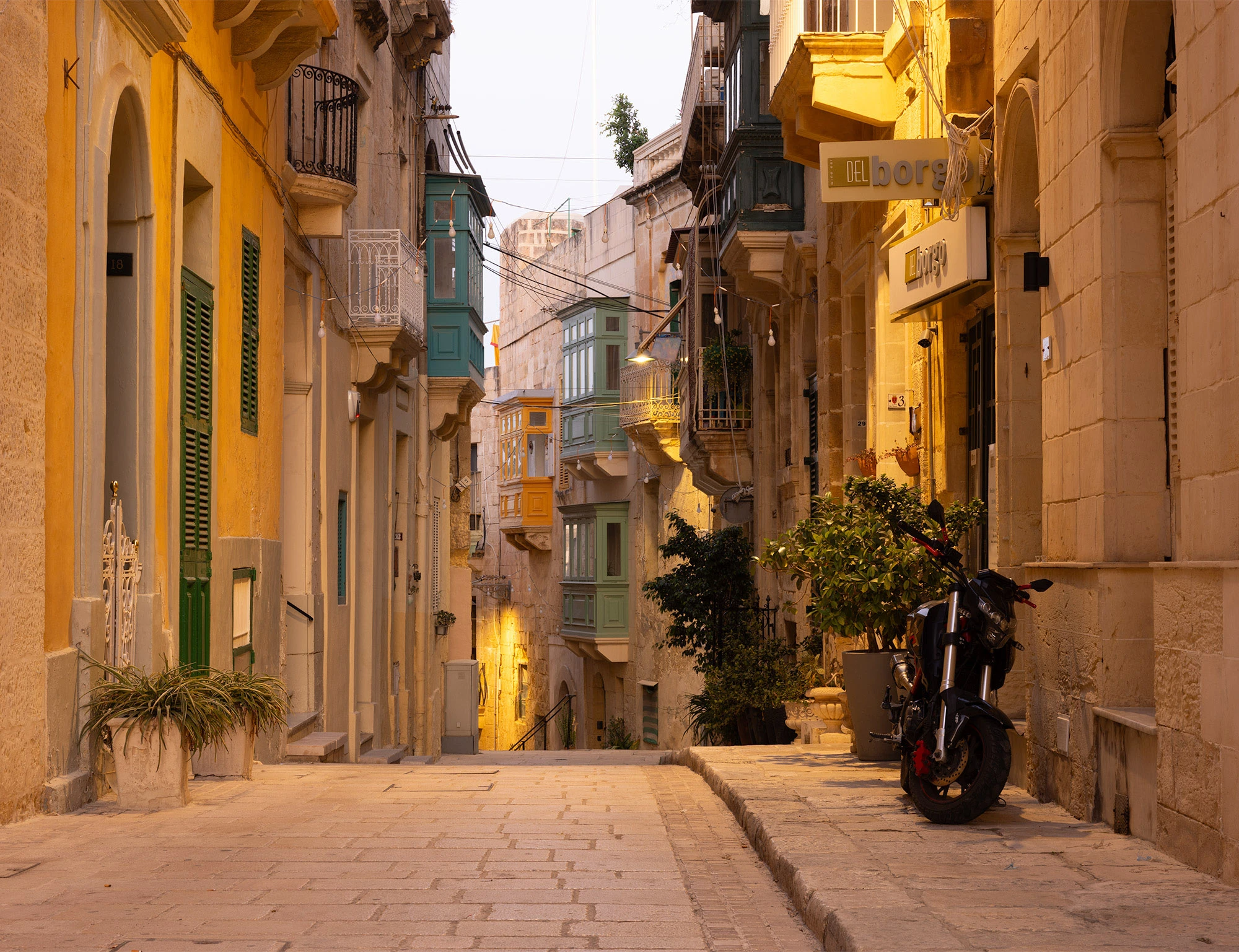
The Ġbejna Journals
in Malta
From Neolithic seafarers to modern refugees, the hidden history of Malta is written in cheese.
Updated August 29, 2025.
T
he sun has not yet risen over Malta. I am explaining to Mebratu, my rideshare driver, about my interest in Malta’s signature cheese, Ġbejna. And that this interest began when, twenty years ago, I invented a sort of muse—a fictional traveler who retired from his career as a maître d' fromage to travel the world in search of its most special cheeses.
“But why make him up?” he says in his Eritrean accent, “when there are so many good real ones, like Bourdain, or that bald guy that eats disgusting food?”
I told him that those people are presenters whose tickets are booked and itineraries planned by someone else. I guess I wanted a muse who was an independent traveler and could see the world through his own experience. I wanted someone who thought that cheese could explain everything about the world because that had been his career and it was his perspective. No one was paying for him to have a presentable perspective.
We take a turn on a bend on the windy road to the southwest coast, when, unimpeded by limestone rock walls or stands of prickly pear and yucca, we see the early morning light floating across the Mediterranean Sea.
“If I see the ocean every day,” Mebratu says, “I am good.” He wags his finger triumphantly. “And I love this view more than any other.”
Mebratu moved to Malta 18 years ago. “I wanted two kids,” he says, “but my wife give me three. So is the way life goes.” And he laughs and explains how grateful he is to be able to live here. “There is peace, and that is all that matters.”
I tell Mebratu how I’d been reading book after book about the savage wars that played out here in Malta, how it seemed like the island nation had been the center of the world’s most brutal battles. But then I started Salt by Mark Kurlansky, and it reminded me that most of the Mediterranean's history is long periods of absolutely nothing.
I explain that my brother said something that stayed with me: history isn’t just the big conflicts. It’s mostly long stretches of people farming, tending goats, making food, raising children, just living. The history books tend to skip those parts. But maybe that’s the history that actually matters.
“I want to forget conflict, so I can understand seeing it like that,” Mebratu says, “but my history is not just living.”
I prod him to tell me his personal history, about how, during the war of Independence against Ethiopia, he was conscripted into the Eritrean People’s Liberation Front at age 10 as a child soldier. “1991,” he explains. “The horror!” He thinks before continuing, “Then war breaks out again when I am 18. I knew then I had to go. It was horror. All horror.”
He fled toward the deserts of Sudan, but lived in a refugee camp there for a year. From there, he took trucks north, on trips so devoid of water and so ripe with intense heat that many people died en route. He lived in Tripoli “for a couple years” and eventually found passage on a rubber boat.
He is still telling his story when we arrive at the entrance of the Ħaġar Qim archeological site.
“What will this place tell you about cheese?” Mebratu says. I tell him, “Nothing. I just want to see it before my wife and son wake up.” But that was more out of respect for the gravity of his story, and it wasn’t quite true.
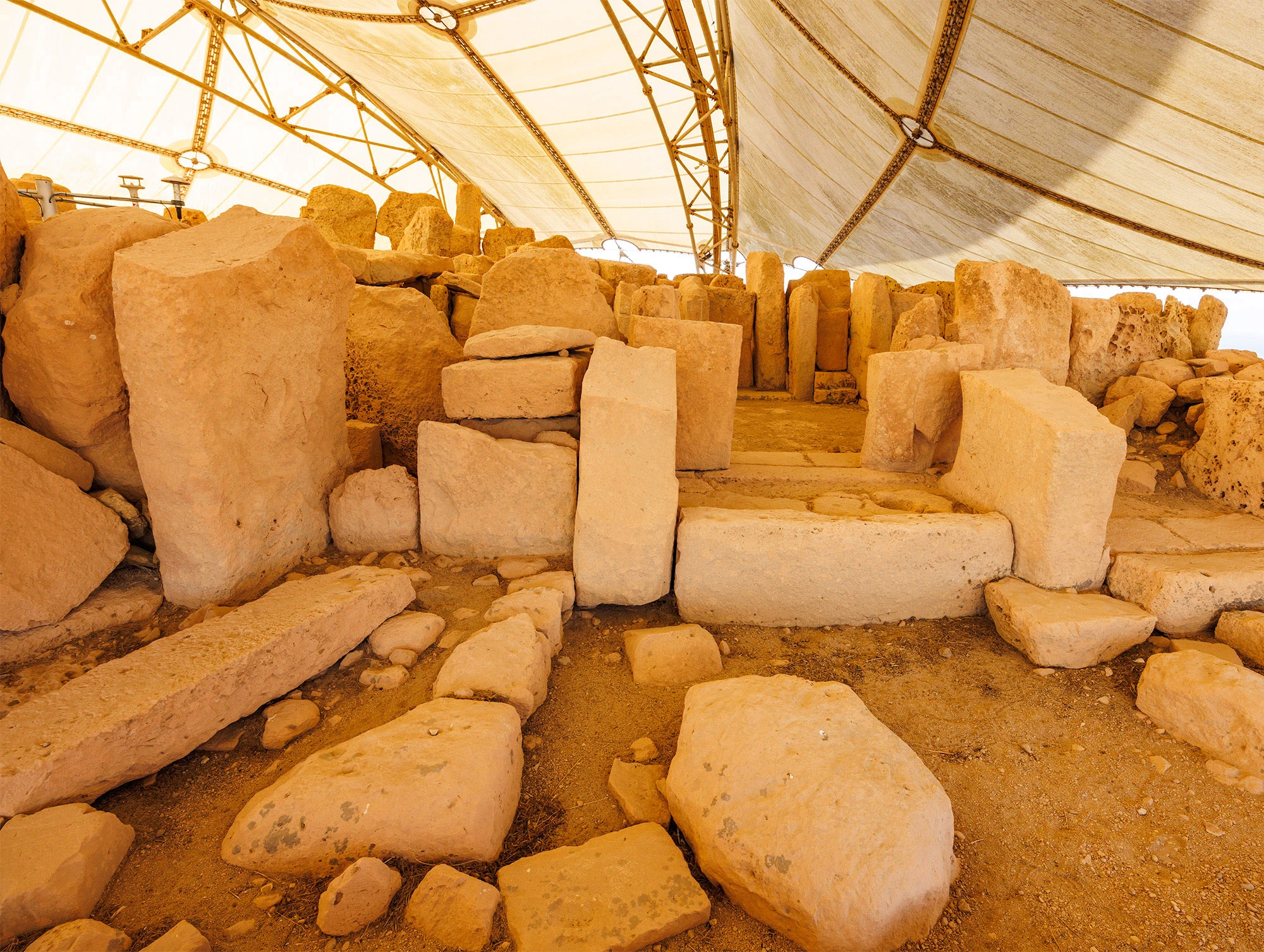
The ancient temple of Ħaġar Qim in Malta underneath its protective canopy.
Ħaġar Qim
I
am sitting outside the visitor center of the archeological park that shares access to the twin Neolithic temples of Ħaġar Qim and Mnajdra. They are both UNESCO World Heritage sites.
Even this early in the morning, the heat swelters. This climate change fueled Mediterranean heatwave is now confirmed as the hottest June the region has ever recorded. In nearby Greece and Turkey, thousands are evacuating as temperatures reach the triple digits. Yesterday, I read a news report about temperatures reaching almost 123 degrees Fahrenheit in Silopi, Turkey.
Here in Malta, temperatures had hit 106 degrees only a few days ago. Today, while those temperatures have cooled to 92 degrees, Malta has been facing unusually high humidity levels. There is none of that expected Mediterranean wind, and the humidity levels are peaking at nearly 70%. I know why I am here early in the morning, and I also know that the walk from the Ħaġar Qim neolithic site to the Mnajdra site is only a third of a mile. But I also know that in this heat, the walk there and back shouldn’t be trifled with.
I walk out to Ħaġar Qim, which is protected from the sun and wind by a giant sail-like dome. This massive prehistoric temple complex sits above cliffs and looks out over blue ocean and the uninhabited Filfla islet. It was built over 5,000 years ago from the same honey-colored limestone that permeates almost every home and building in the Maltese islands. But these are limestone slabs which weigh several tons. They are arranged in curved, cloverleaf-shaped rooms complete with doorways and altars. The walls are weathered, but mostly still standing, and the stones fit together without mortar. The existence of carved limestone statues depicting obese crouching females suggests the temple was used to worship fertility, or possibly nature.
It doesn’t take much to imagine how the temple site looked when it was built. Even if it were built today, we would see it as a masterpiece, an impossibly beautiful space. Archaeologists believe these temples were constructed using only stone, rope, levers, wooden rollers, and muscle. They had no metal tools or wheels. Ħaġar Qim, one of the oldest free-standing structures on Earth, and its existence reiterates that Malta had an organized and successful civilization 5,000 years ago.
I am the first visitor to this temple today, and in the quiet, I try to picture the ancient Maltese building these temples, out here in a place that feels like the end of the world.
So who were they and how did they make it to Malta so long ago?
Seafarers actually existed in the Mediterranean as far back as the Paleolithic age. Archeologists have evidence of seafarers using dugout canoes or skin-boats that were capable of open water navigation as far back as 12,000 years. By the time people first arrived in Malta, the Mediterranean would have already had a 4,000-year-old history of open water maritime history.
The Neolithic Maltese crossed the 56-mile stretch of Mediterranean from Sicily around 5900 BC, about 8,000 years ago. They definitely had a reason to leave. While Malta was uninhabited, Sicily had already seen thousands of years of human presence. Some archaeologists believe it was settled as early as 24,000 years ago.
In the many millennia that followed Sicily’s inhabitation, the early Sicilian farmers gradually overused their land. Around 6000 BC, the island’s soil began to tell that story: forest pollen vanishes from sediment layers, replaced by traces of weeds, cereal crops, and ash. People began clearing their hillsides with fire. Their goats, brought over from mainland Italy, grazed so heavily that the forests couldn’t recover.

My handpainted map of Malta shows all of the cities, towns, bays and archaeological sites described in this series.
A
t first, the soil was fertile and growing grains was easy, but with the slopes stripped bare, the rain began to wash the soil away. Erosion followed, and with it, the slow collapse of biodiversity: fewer wild plants to forage, fewer animals to hunt.
By the time of the crossing, sheep and goats had been grazing across Sicily for generations. These domesticated animals, introduced long after the Paleolithic, were now accelerating the land’s decline. The goats were chomping at the hillsides, desertifying the land. For the Neolithic people struggling on broken land in Sicily, Malta was a new opportunity to start fresh.
When the first Neolithic settlers crossed from Sicily to Malta, they brought with them everything they needed to build a new life from scratch. They stuffed their canoes with sacks of wheat and barley, lentils and flax seeds. They brought stone axes, blades, and grinding rocks for clearing land and processing grain.
They brought clay pots, wooden bowls, and bone needles, fire-starting kits made of flint and pyrite. They wore hides or simple flax clothes, and carried baskets and ropes. From Sicily, they had everything they needed to replicate an organized society in their almost identical, but untouched, new environment.
Among their cargo were sheep and goats. These animals meant meat, wool, and milk, which allowed them to produce one of the earliest forms of cheese.
Archaeologists have found pottery at Neolithic Maltese that contained fatty acid residues consistent with milk processing, and clay fragments that resemble early cheese-strainers have been unearthed throughout the Mediterranean, including nearby Sicily.
The first Maltese cheese was almost certainly simple, soft, probably moister and softer than Middle Eastern Labneh, almost like a yogurt. If it tasted similar to modern cheese, it would be the yogurt-like Jben that was the first cheese I ever wrote about.
This first cheese of Malta was almost certainly made using rennet from the stomachs of young goats or sheep. That rennet is an enzyme that curdles milk by separating it into solid curds and liquid whey. They probably used woven baskets to drain the curds, forming soft, fresh cheese similar to yogurt or feta. Without refrigeration, some of it would have been dried in the sun to preserve it for later use.
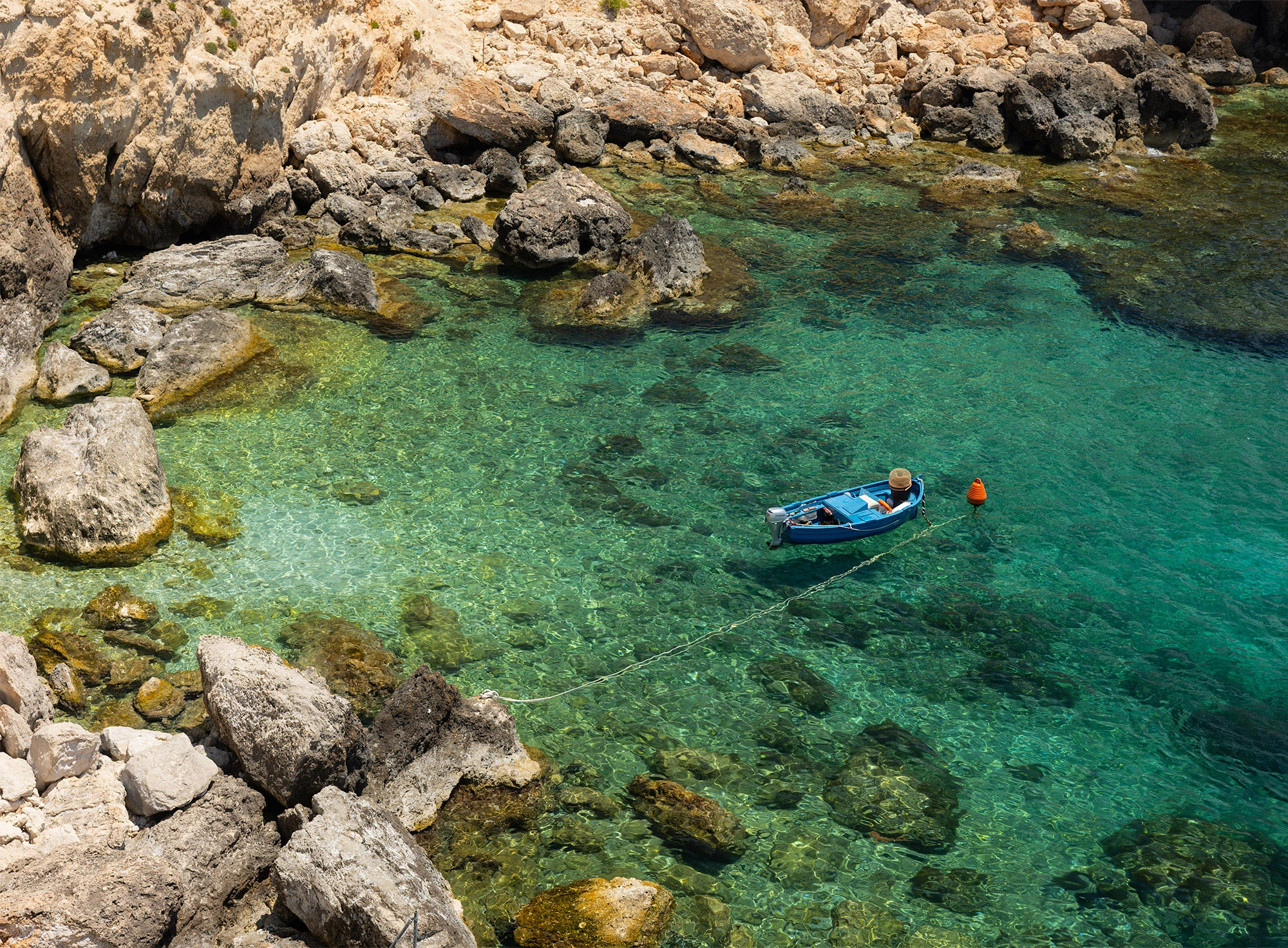
This tranquil swimming hole of Għar Lapsi lies just a short distance down the hill from the megalithic temple sites of Ħaġar Qim and Mnajdra.
Mnajdra
I
begin the short, but intensely hot walk from Ħaġar Qim to Mnajdra with my ice-cold water, thinking about Mebratu’s trek across sunbaked Sudan and Libya. Could he even survive the same trip today, in 2025, versus back then in 1998? Summer heat levels of 122 Fahrenheit, common today, would have been unheard of in 1991, and heatwaves in the African Sahel have doubled. But the water sources are drying up too. With fewer water stops, the hazards of migration are increasing.
Today, we can see floods, wildfires, and hurricanes growing more severe, and it’s easy to deduce that climate change is making them worse. But these are survivable events: floods recede, hurricanes can be evacuated, fires outrun. Cities rebuild. The news often treats them as the worst consequences of climate change. They’re not. The real danger lies in the collapse of biodiversity, the drying of freshwater sources, and the unraveling of agriculture. Human civilization will likely fall before the most extreme ecological thresholds are crossed, because it takes far less to unseat humanity, driving it to abandon its institutions of education, Democracy, and science, causing it to collapse into chaos and conflict. Just look at how quickly the pandemic brought the world to a halt.
In North Africa and the Middle East, this unraveling has already begun. Climate change has become a dry, world threat multiplier, accelerating conflict and creating new cracks of instability.
In Syria, a devastating drought that lasted between 2006 and 2010 displaced a million people, fueling unrest that tipped the nation into civil war. In Yemen, the water tables have collapsed after decades of overuse, and climate-driven drought has deepened an already catastrophic conflict.
Libya’s freshwater infrastructure has crumbled alongside the nation’s political chaos. In both Iraq and Iran, sandstorms, water shortages, and agricultural collapse are bringing chaos to the countryside. Egypt is seeing rising tensions with Ethiopia over control of the Nile, as climate change alters rainfall patterns near the river’s source. In the Sahel and southern Sudan, worsening droughts and desertification have intensified ethnic violence and driven mass displacement.
Democracy vanishes quickly with drought and heat. Rising heat, vanishing water, and parched farmland push already-fragile societies toward the brink.
The same anti-immigration sentiment that simmers across the Mediterranean today exists equally in Malta too. But what about a hundred years ago? St. Deuberex Montclair, my fictional cheese traveler, would have witnessed it firsthand as he rode the rails through Europe in the years before and between the World Wars. From his seat in a train, looking out across endless Mediterranean towns, he would have seen a continent gripped by rising nationalism and a growing disdain for outsiders. If you wanted to blame your hardships on someone else, there was an anti-immigrant rhetoric out there to intoxicate you.
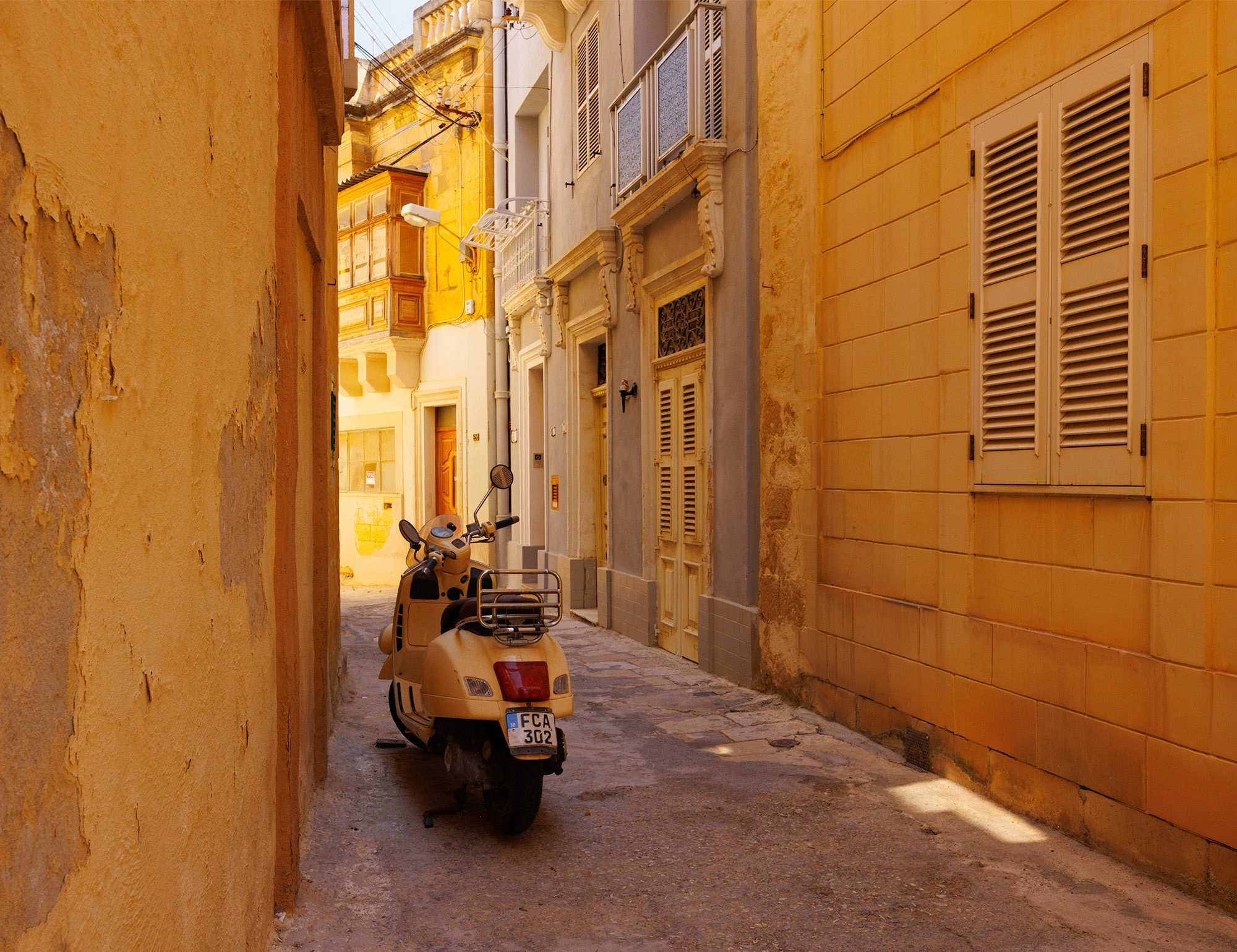
Malta's omnipresent honey-colored limestone is a unifying aesthetic throughout the island, and has been used in every era of the small nation's history.
M
ontclair might have spoken up when he overheard slurs aimed at Eastern Europeans, Jews, or the Roma — communities he knew well. He was part French, part British, and part Roma himself, and as a Maitre’d fromager, he would have collaborated with immigrants at every level of the food world. He understood that immigration came with both costs and benefits, and he believed nations had the right to shape their policies by balancing their national interests and values. But what he saw in those years wasn’t debate over costs and benefits at all, it was blind fervor, weaponized by something truly sinister, and an innate switch that can be easily turned on among our dimmest bulbs. And he could sense it wouldn’t end well for Europe, not once, but twice.
When I find relief under Mnajdra’s protective canopy, I try to make sense of this structure and how it’s different from Ħaġar Qim. In fact, Mnajdra gives a very big hint about the true purpose of these temples.
Here, the rising sun shines directly through the main doorway during the spring and autumn equinoxes, illuminating the central axis of the temple.
On the summer solstice, the sunlight hits a decorated slab on one side of the doorway, and on the winter solstice, it hits a similar slab on the opposite side. This precise astronomical alignment shows that Mnajdra was a giant solar calendar, a tool to help its Neolithic farmer-builders track the agricultural seasons.
The cheese those first migrants made, the first Maltese cheese, is lost to time. But if I follow the imaginary trail left by St. Deuberex Montclair, I’ll find that Malta’s most beloved cheese, Ġbejna, isn’t a relic of a single moment. It’s a living artifact, shaped by thousands of years by successive waves of immigrants, each one bringing their own herds, their own methods, their own hopes. In Ġbejna, we can understand Malta not by its horrific conflicts, but by the thousands of years in between.
Part II: Marsaxlokk
I
t’s an hour before sunrise, and I’ve arrived in the fishing village of Marsaxxlokk to watch the fishermen head out to sea. Some Maltese fishermen still leave Marsaxxlokk Bay in double-ended hull, brightly painted fishing boats, known as Luzzo. Luzzo boats have prows that are painted with the Eye of Osiris, a symbol of protection and bounty at sea. They tell a story; the next chapter of cheese in Malta.
Marsaxxlokk’s namesake bay has served the island as a protected harbor since the Neolithic age. In prehistory, the boats in the bay were likely simple dugout canoes or reed boats. There may have even been simple plank boats, stitched together with fiber and leather.
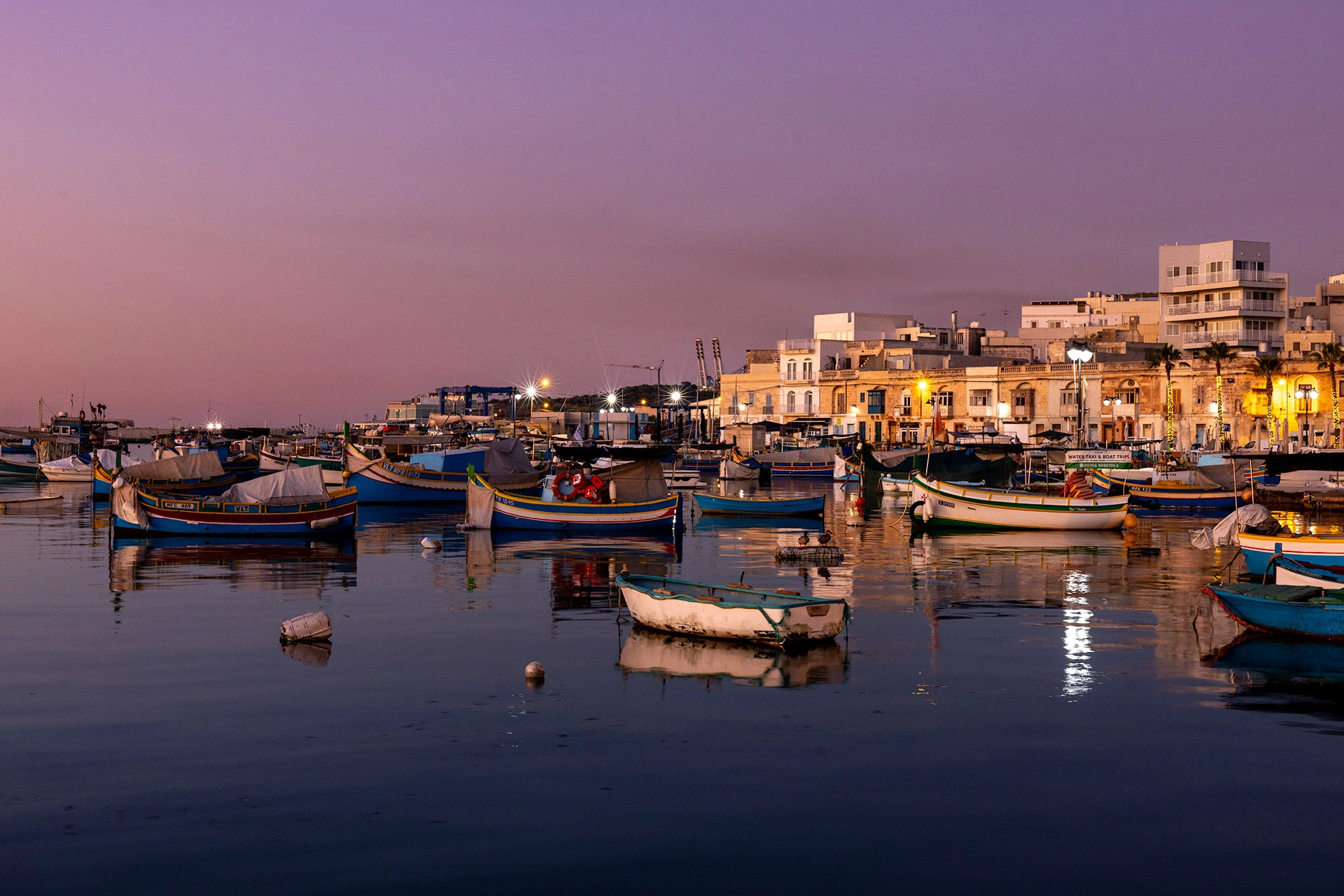
Marsaxlokk Harbor awakens before dawn, as fishermen head out to sea, or return from night-time 'calamari' fishing.
B
ut something was amiss in Malta. By 2,500 BCE, the neolithic civilization that built Mnajdra and Ħaġar Qim no longer existed. They overfarmed, overgrazed, and deforested Malta and Gozo, leaving the Maltese islands bare and desertifying them as much as the Sicily they escaped from three thousand years before. Their once-advanced society slowly unraveled under the weight of its own environmental collapse.
While the civilization perished, scattered Maltese hung on. They fled to the highest elevations, places where crops could still thrive, and where they could build camouflage settlements, complete with defensive walls and moats. As maritime technology began to improve across the Mediterranean, so did the opportunities for raiders and pirates to pillage quiet, distant islands, emptying coastal villages.
In the 8th century BCE, Phoenician ships began to visit Marsaxlokk Bay regularly. These ships were technological marvels of their age: double-ended hulls built for speed, balance, and longevity, with high prows painted with protective eyes to watch over the voyage. Their design was so sound and seaworthy, that Malta has carried the design forward for three thousand years. The luzzu boats I see this morning, with their rounded, double-ended hulls, their bold bands of orange, red, blue, yellow, and green, and the watchful eyes painted on their bows are twentieth-century descendants of those Phoenician craft.
The Phoenicians arrived as merchants in ships carrying Levantine timber, murex dye, salted fish, amphorae of wine, and…livestock. To them, Malta was a strategic stopover for trade further west. But it was so essential to them that many of them stayed. Malta’s language, customs, and religions eventually folded, overlapped, and mingled with all things Phoenician. From the Levant, these traders brought new hardy breeds of goat and sheep, animals that had been bred to thrive on rocky uplands. They were also prized for their rich milk.
In Malta, where rain was scarce and pastures thin, these goats and sheep thrived. They interbred with Malta’s local stock, producing flocks that gave more milk and milk of a quality better suited to curdling and storage.
For the Phoenicians, dairying was as important as the milk itself. They had perfected techniques of preserving milk into food that would endure. They were experts at creating salted cheeses, among which they used to help sustain their sailors on long sea voyages. We know this rom clay strainers and amphorae found in Phoenician settlements from Tyre to Cádiz.
The Phoenician cheesemaking skills would have pervaded Malta. From the newly arrived immigrants, the Maltese would have learned to curdle milk in woven rush baskets, pressing cheese wheels to harden in the sun, and salting curds to last through summer droughts.
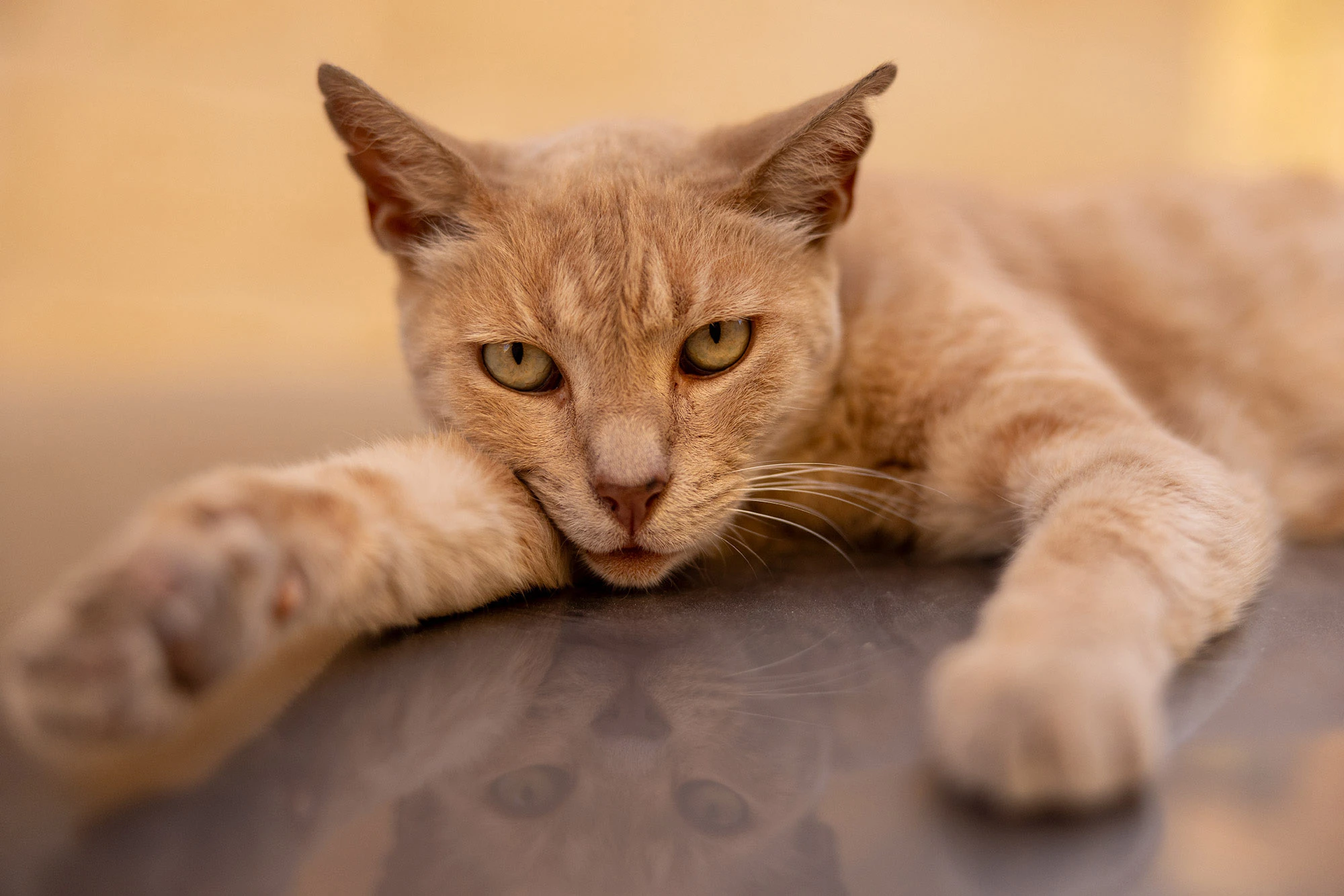
Photographed in Birgu on a sweltering evening, this alley cat carries the same watchful, sea-hardened spirit as the fishing harbor cats of Marsaxlokk.
A
lready sweating, I sit on a bench, glugging my ice water, watching two alley cats playing beneath a drydocked luzzo. I nearly miss a fisherman slipping into his skiff. “They are good cats,” he says as he paddles out toward the luzzo he says was passed down from his grandfather. While he works along its hull, I ask about the colors. He points to the thin line on the bow. “This is the mustache. All luzzo have the mustache. It is part of the face.” The red and yellow, he explains, tell other fisherman that it’s from Marsaxlokk; another boat farther out, he can tell at a glance, is from St. Paul’s Bay.
I can imagine this man’s grandfather setting out from this same bay 60 years ago. I imagine Montclair writing about this place in his imaginary notebook, Cheese Travel in the Central Mediterranean. Maybe this scene would make him quip about the fashionable recipes of Paris, which he didn’t disrespect, but saw as something fleeting. Of that year’s favorite recipes, Oeufs à la Chimay or Crêpes Suzette flambées, he might have said:
“The dish of the day parades its novelty, but the elemental foods do not change their character. Bread, oil, vinegar, wine, and cheese evolve with their makers each year, with each region stamping them with its climate and custom, making them the most complete mirrors of a place and its long history.”
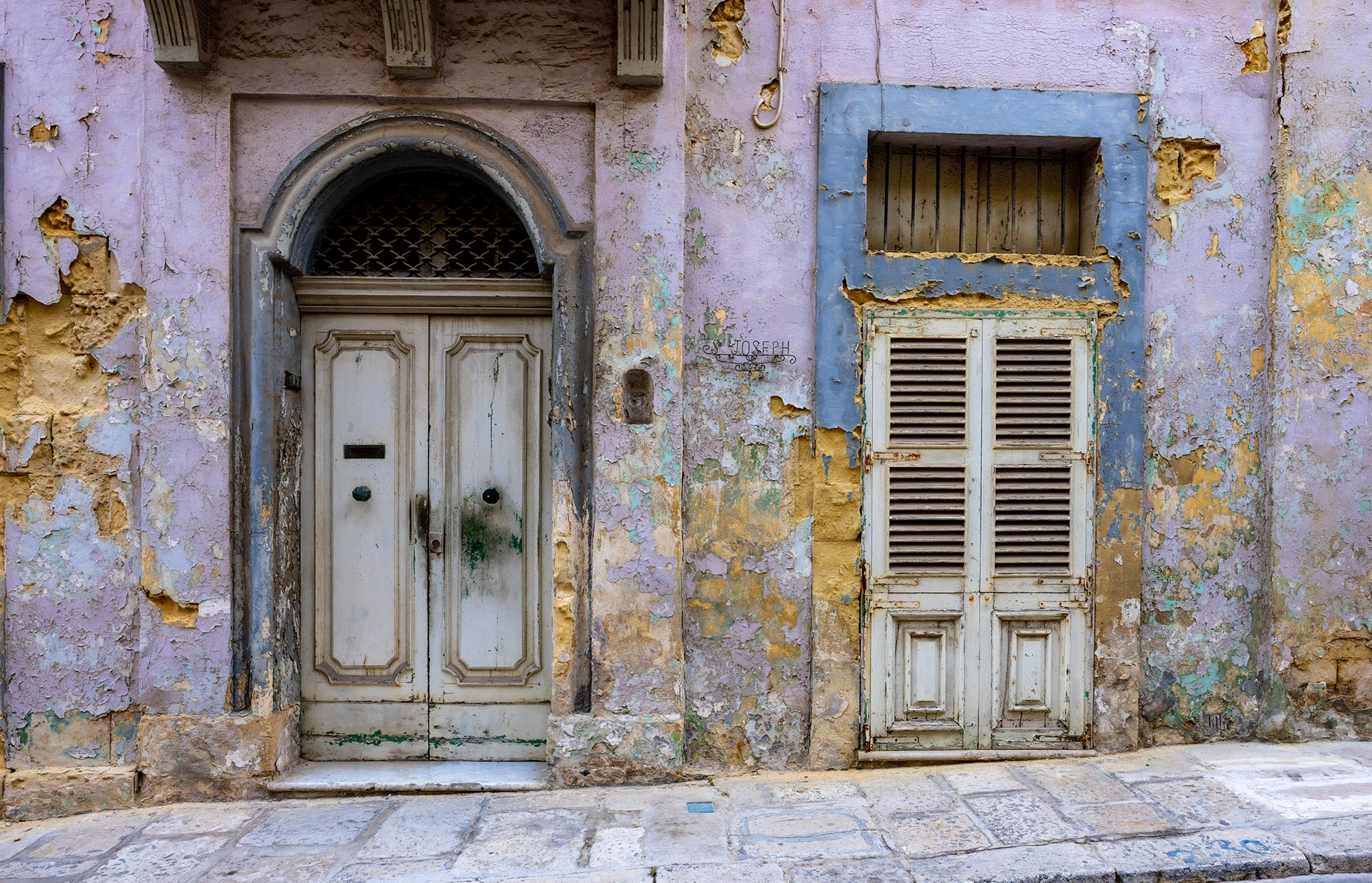
These Birgu doors show the island's porous history, layers of cultures and eras pressed together, weathered, and preserved into something enduring.
T
oday, the world celebrates about 4,000 types of cheese. But when Montclair was traveling through Europe in the 1920s, cheeses were being forgotten, or even on the verge of being lost forever. To many in the 1920s, cheese had consolidated to the “best”, and most exportable: Cheeses like Roquefort, Cheddar, Manchego, Parmigiano Reggiano. But the specialty cheeses that are now considered among the most lovely, unusual and spectacular were almost lost in a century of hyper-industrialization, war and communist collectivism.
Ġbejna does not share the relative global fame of cheeses like Appenzeller or Mimolette or even Époisses de Bourgogne; even though it is beloved in Malta, it is a hyper-local cheese almost unknown anywhere else. But those semi-famous cheeses were almost lost too.
His acquaintances, although not his clients, would have been frustrated with him at times for his interest in unknown cheeses. “If you want to travel for cheese, you stay in France!” they might have said.
But there were real world Montclair’s — food and travel writers who understand that the hyperlocal cheeses found in the most faraway corners of Europe weren’t backward relics of the last century, but intrinsic cornerstones of gastronomy. It was often these writers, paired with a handful of local farmers, whose dual passion led to keeping most of those 4,000 cheeses alive in an age that wanted them to be forgotten forever. They were the string that held them up until governments and slow food movements intervened.
Salina Bay
C
onstantino, a rideshare driver, picks me up hours before predawn. He usually starts his work day around 3:30 AM, but, “I slept in an hour. It was a late night last night.”
Partying, I ask? “No, no. Miss Universe Pageant.”
”Really?” I ask. “It’s my daughter. She has been in pageants her whole life. She wanted to see this. She is competing for the regionals in Żebbuġ. There she won number six for most photogenic, number three for best personality and number four for beauty with a purpose!”
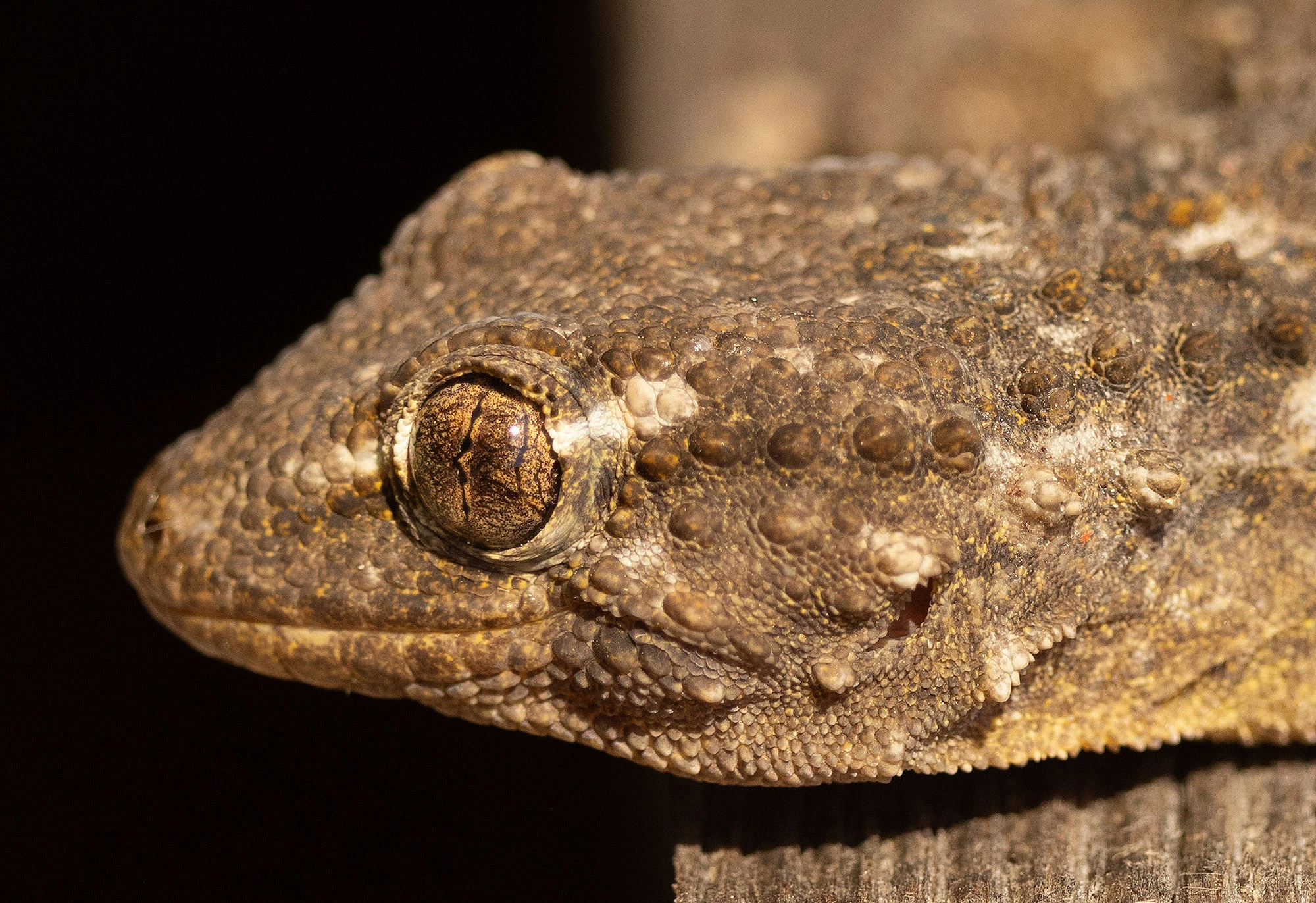
Perched on a fence at the Salina Nature Reserve, the Moorish Gecko is an immigrant species that, like so many before it, has found a lasting place in Malta.
I am impressed by a dad’s dedication to his child’s hobby, but then our conversation turns to his honeymoon. “Two weeks in United States! We saw all the studios! Dynamite Nights Stunt Spectacular was our favorite.”
“What was that?” I ask.
“Miami Vice! They are on jet skis and explosions everywhere!”
Having spent a third of my life in Los Angeles, I recognize the showbiz parenting in this, and wonder if this is truly their daughter’s passion. Stage lights are poor substitutes for sunlight in a young life, and no ribbon or sash makes up for the loss of carefree youth.
When we arrive at a pullout in a roundabout, Salina Bay Nature Reserve, on Malta’s northern coast, Constantino looks out the window for a moment.
“I have lived on Malta my whole life. I have never been to this place.” He says, referring to the reserve, and with his arm over the wheel, a dumbfounded expression on his face.
Salina Bay is a large and narrow inlet that funnels into a series of salt pans. At the tip of the funnel, its edges are stitched with low stone walls and rectangles of shallow water.
The Phoenicians were the first to see what the bay could offer. They coaxed salt from the tide with rough channels and shallow basins, letting the sun and wind finish the work. Salt was wealth in a form that could be loaded by the sack, carried in a single hold across half the Mediterranean. But the Phoenicians thought like traders, not industrialists.
It was the Romans who, after conquering the Carthaginians (who were themselves inheritors of the Phoenician trade routes) in 218 BCE, turned Salina from a local mine into a machine. They squared the saltpans, deepened the channels, and reshaped the shoreline. The long, low warehouses they built could shelter mountains of salt from rain and spray, ready shipment to Sicily, Ostia, or Carthage. Under Rome, Maltese salt was counted, taxed, and moved by market forces as predictable as the tides.
Most of it went away for export. But some of it stayed. The Romans understood better than the island’s earlier residents that salt could change the life of milk, stretching it from days into weeks. Salt from Salina made its way to the farms of Malta and Gozo, making it possible for dairy farmers to dry and store simple cheeses, as well as to prepare curds that could survive a long journey over rough roads or across the channel to Sicily.
The salt pans are dead quiet at dawn, and they catch the reflection of modern, run-down apartment buildings in the distance. Out beyond the low walls, dozens of fiberglass boats are anchored everywhere. Salina, once industrial, is now a nature reserve, its brine flats are protected for the birds that cross here on migration.
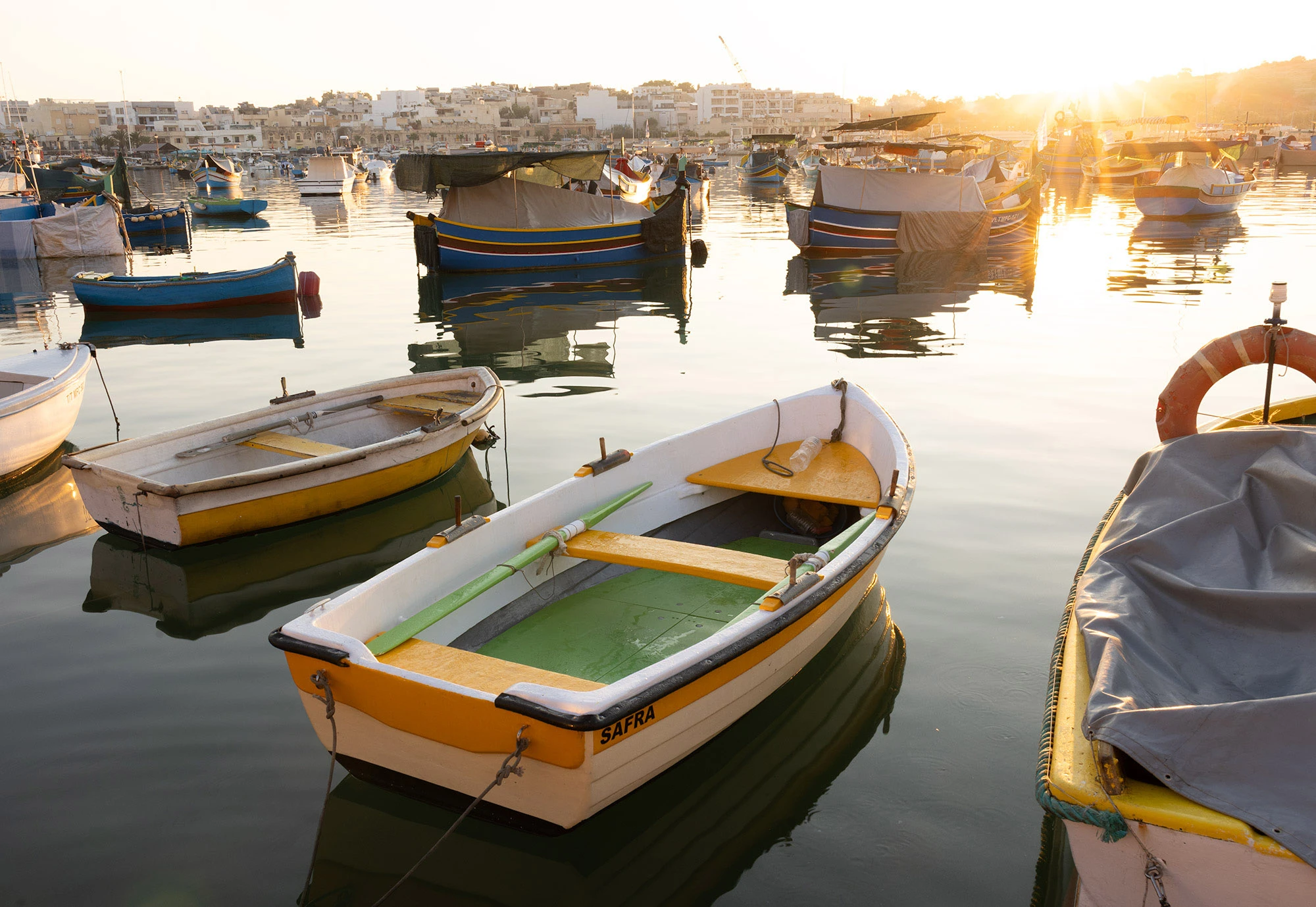
At Marsaxlokk Harbor, the day begins with small skiffs and painted luzzu boats catching the first light, as they have for centuries of trade and migration.
I
t’s summer, and in summer Salina is the only reserve that remains open. The nearby estuaries, the only others in Malta, are closed because they simply dry up and are nearly devoid of any life at all. Without rivers, summer has nothing to offer the hundreds of species that migrate back and forth between Europe and Africa.
I find a man staring out with a telephoto lens at the mostly empty salt flats from a blind. I sit down next to him and ask him if there is anything interesting out there. Mario has been a volunteer with BirdLife Malta since the 1970s. He began banding birds in 1976, the year the salt pans were still an industrial place.
Lately, he explains, he’s been spending a lot of time banding Common Swifts. “When you band them, you have to lock this tiny oval ring around their leg. So you have them on your hand, but their legs lock on you.” He shows me the scratches, nicks and cuts on his hand. “To get them off, you have to thrust up like this.” He jolts his arm upwards. Today, he is scanning the small population of Yellow-legged Gulls on the flats, watching for the flash of metal rings on a leg.
In Europe and North Africa, color bands attached to gull legs create field-readable IDs. The “code” is made up of the color, position, and any alphanumeric characters on the ring, read top to bottom, left leg to right leg. A red band doesn’t universally mean one thing, as colors are assigned by individual ringing projects, all registered in the European Colour-Ring Birding database. For example, Belgian gulls may carry large white or yellow rings with black letters, Mediterranean projects often use red rings with white codes, and Nordic codes frequently use blue rings with white lettering. The important part is not the color itself but the unique combination of color, lettering, and placement, which identifies the bird’s origin and history.
Mario shows me his laminated cheat sheet which shares different codes of different gulls. Some were born in Croatia, Slovenia, Hungary, the Netherlands, Norway, Denmark, Poland and Russia. When he spots a new gull band, he can contact the bander from the bird’s country of origin and ask about its life history. From these replies, he learns how far the bird has traveled, how old it is, and its route across seas and seasons.
The gulls rest here on their way to somewhere else, as they did when Phoenician traders landed here. They rest here just as the Romans, Arabs, and Sicilians came and went. The routes change, but the pattern holds: arrivals, departures: lives linked by this island and the salt water around it.
People are not banding birds for the fun of it. Much of it has to do with learning how bird populations are changing alongside our changing climate. Often, it means birds are shifting their populations northwards. I was the first to see and report a Pearly-eyed Thrasher in the northern Bahamas, the northernmost record. An individual sighting is one thing, but consistent data is another. Citizen sightings, bands, and GPS trackers together help tell a statistically relevant story.
Sitting here with him, the salt pans feel less like the ruin of a forgotten industry and more like a ledger of crossings. Each banded bird is part of a record, each migration a footnote in a long history of comings and goings that have shaped Malta.
It was actually the Northern Bahamas where I started thinking about this intersection between climate and immigration.
In 2019, Hurricane Dorian struck the Abaco Islands with sustained winds of 185 mph and surges over 20 feet. It was the strongest hurricane ever to hit the Bahamas. The Abacos, where I spent part of my childhood, were devastated. Nearly every building in Marsh Harbour was damaged, and entire Haitian migrant communities like The Mudd and Pigeon Peas were flattened. The true death toll will never be known, but some quietly estimate thousands.
The storm was a reminder that climate kills immigrants first, and that immigration politics are universal: when societies take the wrong approach, everyone loses.
Just days later, the Miami Herald highlighted Craig Roberts, developer of Bahama Beach Club, who built a hurricane-proof church as a shelter for his undocumented Haitian workforce. He understood that protecting them was essential to the island’s economy. At the same time, the Washington Post reported on Bakers Bay Golf & Ocean Club, a luxury enclave that evacuated its ultra-wealthy homeowners while leaving hundreds of Haitian workers in flimsy, flood-prone settlements. Between 300 and 800 Haitians, most employed directly or indirectly by Bakers Bay, died in Marsh Harbour.
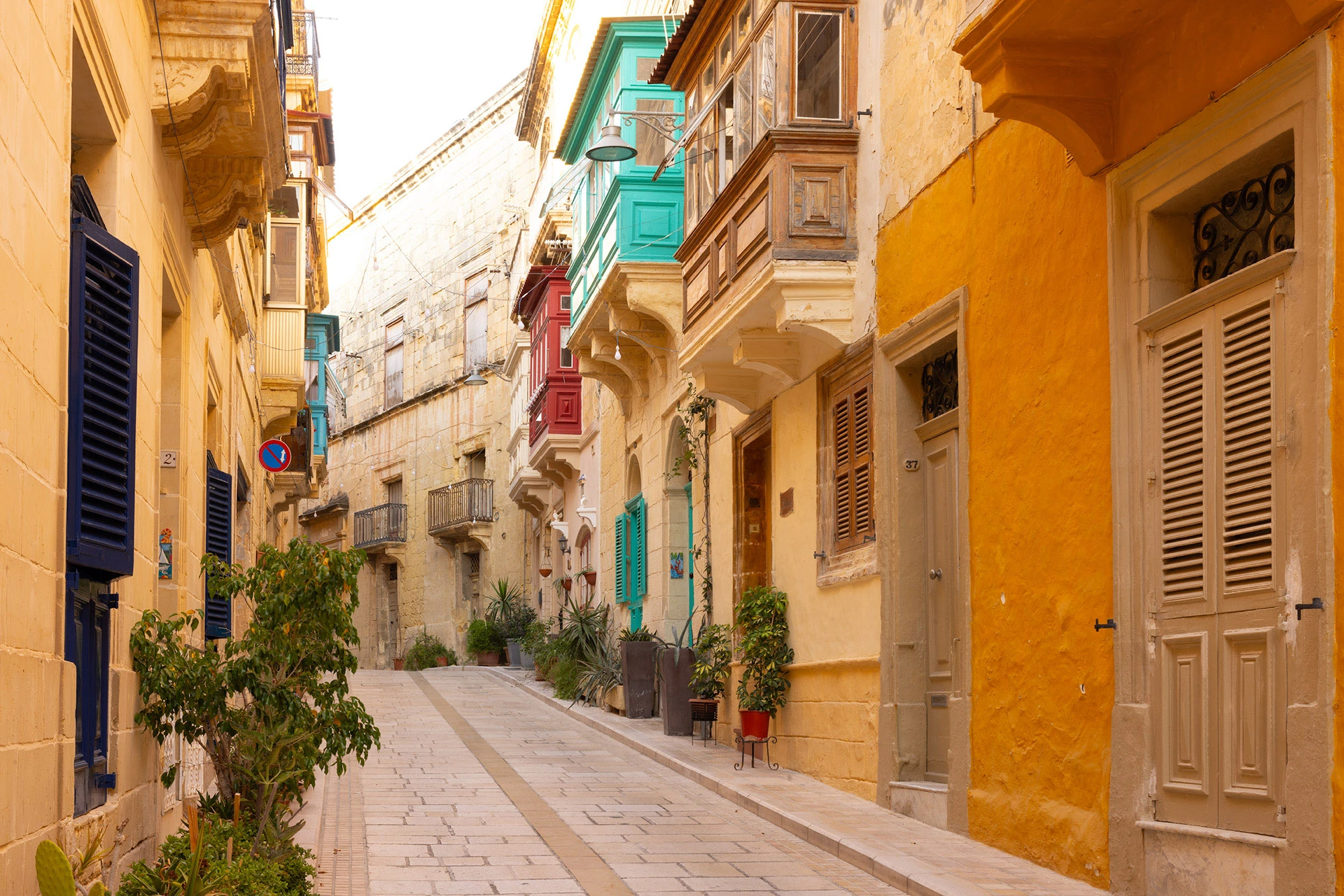
Malta's narrow streets glow with painted balconies and limestone walls, each turn revealing layers of history and daily life.
T
he contrast is stark: Roberts chose moral responsibility; Bakers Bay did not. And as in so many places, blame is tangled—immigrants crossing illegally, developers exploiting their labor, locals refusing the work yet denying them legal paths. The cycle leaves the most vulnerable in an exploitative state.
Here in Malta, thinking about that Pearly-eyed Thrasher and those guys I knew my whole life, but who I never saw again after 2019, I understand that it is all part of the same story.
There’s immigration enforcement here in Europe that works. You see it in the patrol boats, processing centers, and the machinery of borders. And there’s the other kind too: the ugly, feverish version, feeding on slogans and suspicion, turning strangers into enemies before they’ve even stepped onto the quay. It’s easy to get pulled into arguing the merits of policy and the limits of law, and there is truth in the idea that a country can, and should, guard its borders.
But even sound immigration policy is a wall built on shifting sand. The bigger story isn’t just about the people from Africa or the Middle East making dangerous crossings to reach Europe. The bigger story is that the climate itself is moving the map lines. The same heat, drought, and failed harvests that are driving farmers from the Sahel will also move Italians, Spaniards, Greeks, and Maltese northward when their own land and water give out. The real immigration debate isn’t about border patrols or asylum quotas, but about climate policy.
Malta’s whole story is a tide of arrivals. The island has been Phoenician and Punic, Roman and Byzantine, Arab and Norman, Aragonese and French, British and Maltese. Malta is a porous membrane; each wave left something behind. Malta’s strength is not its purity; but its layers of diverse culture.
In that way, It’s not so different from where I live, the place I call the Far West: California, Oregon, Washington, and Hawaii. I have hypothesized for a long time that the beginnings of an answer to the intersection of climate and immigration can be hinted at out here.
Taken together, these four states make the world’s third-largest economy. As an entity, this region edges out Japan and Germany. There are many reasons for this region’s enormous and unparalleled economic success: good soil, tech, entertainment, and ports.
But there is something else unique to the American Far West that glues all these other things together: the Far West is the most diverse place on Earth. More languages are spoken here than anywhere else. More religions are practiced here — also, more lack of religious affiliation. It thrives on multidimensional diversity. And more than ethnicity: age, origin, gender, religion, and the intermingling of people from rural and urban communities. It is an imperfect but undeniably dynamic mix that fuels innovation, resilience, and global reach. This richness is deepened by a porous membrane of undocumented immigration, which adds new energy, skills, and perspectives to the region’s economy and culture.
And in my region, the contribution of undocumented immigrants is not just cultural; it’s structural. They harvest crops, build homes, clean hotels, cook in restaurants, care for children and elders. They hold up whole sectors of the economy. We are strong not in spite of them, but because of them — that porous membrane of the Far West is its unifying strength. Diversity in all forms equals tolerance, innovation, creativity, and work ethic.
The Far West has shown what works: openness paired with smart governance, diversity as an economic engine, tolerance as a civic value. In California, Oregon, Washington, and Hawaii, people from everywhere work side by side, documented or not.
What I see in the United States under the second Trump administration is a politics of punishment. Mass deportation budgets swell to $170 billion; FEMA staff are pulled from disaster response to serve ICE; citizens are detained for their surnames; birthright citizenship is attacked. Military bases turn into detention camps, humanitarian parole is ended for hundreds of thousands, and raids sweep farms and towns more to terrify than to solve.
Cruel, and definitively flawed. A policy that treats migration as a crime to be crushed instead of a reality to be managed is going to collapse under its own weight, even as it scars people and economies in its collapse. It ignores the climate pressures building in the global south and the Mediterranean. It ignores the droughts and floods that move millions whether politicians like it or not.
Here again, the Far West shows another path. California and Washington lead the world with aggressive emissions targets and renewable mandates. Oregon and Hawaii push forward with solar, wind, hydro, and geothermal projects and industries. Cities invest in wildfire resilience and water conservation. Universities and tech companies pioneer climate science and clean-tech breakthroughs.
Europe can follow this model, where immigration is integrated with economic planning and social investment, or it can mimic the MAGA regions of the U.S., where fear and cruelty rule. One path follows climate science and compassion; the other is what America suffers now: policy not only unjust and uninformed, but destined to fail.
Climate change will make the tide literal and figurative. Rising seas, failed harvests, and unbearable summers will push people across the Mediterranean and across Europe. It won’t just be the farmers from Sudan, but families from Sicily, Andalusia, even from Malta itself, all moving north in search of livable ground.
The real immigration debate here, and everywhere, isn’t about stopping movement; it’s about preparing for it. Malta’s past shows that movement can be strength if it’s met with planning, compassion, science, and a place for everyone at the table. But for all their ships and salt, neither the Phoenicians nor the Romans had the craft to make Malta’s most enduring food. That distinction would come later, from a culture that thrived as a porous membrane itself, drawing knowledge from India, Greece, and Spain, weaving science, agriculture, and taste into something new. Out of that long current of exchange, Malta’s Ġbejna cheese would finally take shape.
Part III: Gozo >